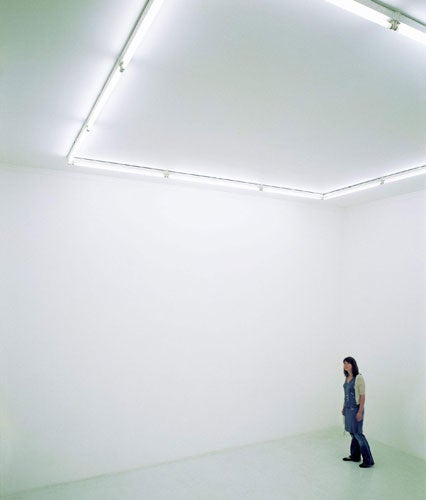The art of nothing: Pompidou Centre celebrates half a century of minimalism

Art exhibitions without exhibits are nothing new. Nothing has been a recognised art form for half a century. But the Centre Georges Pompidou in Paris can claim a cultural first this week: a retrospective exhibition of 51 years of exhibitions without exhibits by nine different artists. How can a museum retrospectively exhibit nothing? With great care. The 500-page catalogue costs €39 (£34).
The exhibition, Voids, a Retrospective, fills, or fails to fill, five rooms in the French national museum of modern art on the fourth floor of the Pompidou building. All the rooms are entirely empty. The walls are white. The floors are bare. The lighting has been arranged just as carefully as for any other temporary exhibition. The gardiens (guards) watch suspiciously to make sure that the visitors do not touch anything, or in this case that they do not touch nothing.
The aim of the retrospective exhibition – refused by several other leading museums in other countries – is to celebrate and explore a movement begun in Paris by the minimalist artist, Yves Klein. Klein, influenced by Zen Buddhism, was the first artist to present an exhibition of blank walls at the Galerie Iris Clert in Paris in 1958.
Klein's exhibition of nothing has been revived for the Pompidou show (which can be seen, or rather not seen, until 23 March). In theory, the Pompidou is not presenting the same nothing because these are not actually the same blank walls. There are, explanatory panels with the same explanations.
Klein's blank walls are a "specialisation of sensibility to raw materials through stabilised pictorial sensibility". In other words, by seeing nothing, you are encouraged to see everything more clearly.
The Pompidou retrospective also revives the celebrated (briefly) Air Conditioning Show assembled (or rather not assembled) in 1967 by Art and Language, a British artists' collective. The show exhibits air-conditioned air in an empty gallery with white walls. Five curators have worked on the Pompidou's retrospective of nothing art, which includes works – or non-works – by seven other artists: Robert Barry, Stanley Brouwn, Maria Eichhorn, Bethan Huws, Robert Irwin, Roman Ondak and Laurie Parsons.
One curator, Mathieu Copeland, says the exhibition is partly an exploration of art as the rejection of art: a refusal to add to a world already too cluttered with images. "But it is not just a kind of radical, conceptual art. You are also invited to explore, in a very physical way, each different space, all of which have a different texture. It is a true experience."
One of the five spaces is devoted to a work by Roman Ondak, More Silent Than Ever, first shown in Paris three years ago. The room is empty, just like all the others, but a panel tells the visitor that, somewhere in the room, there may be a concealed listening device. The aim seems to be to encourage visitors to examine nothingness very carefully.
A group of 20 teenagers were being shown around the Pompidou retrospective yesterday by their teacher. All, or almost all of them, including the teacher, were dressed in black. Against the white walls, they resembled pieces from a chess set. The teacher, rather convincingly, praised the exhibition while the teenagers tried to stand on one another's feet or trip each other up.
Tom Lubbock: A critic's view
Empty? It depends what you mean. The earliest case was not a room but a piece of music – John Cage's 4'33", where the pianist sits for four minutes and 33 seconds without playing a key. Many say there's plenty to hear in the silence.
The winner of the 2001 Turner Prize, Martin Creed, exhibited an empty room at Tate Britain. Or was it? The lights switched on and off every five seconds. That made it a pretty full, eventful room, no?
These works follow a typical trajectory of modern art. Step by step, from reduction to reduction, we make a clean sweep, from figuration to abstraction, to a uniform canvas, to a blank canvas, and then to a blank wall.
Having arrived at emptiness, fill her up again – with meanings. Sometimes the emphasis is on absence, on contemplating nothingness. Sometimes it's on noticing what you might have overlooked.
Perhaps you should notice all the gallery background noises you ignore. Perhaps you should see that art has its environment, which crucially conditions our experience of it. Or perhaps you should be looking at the only exhibits that remain in your empty gallery – yourselves.
The empties are always going to be full of something. The art consists of working out what.
Join our commenting forum
Join thought-provoking conversations, follow other Independent readers and see their replies
Comments